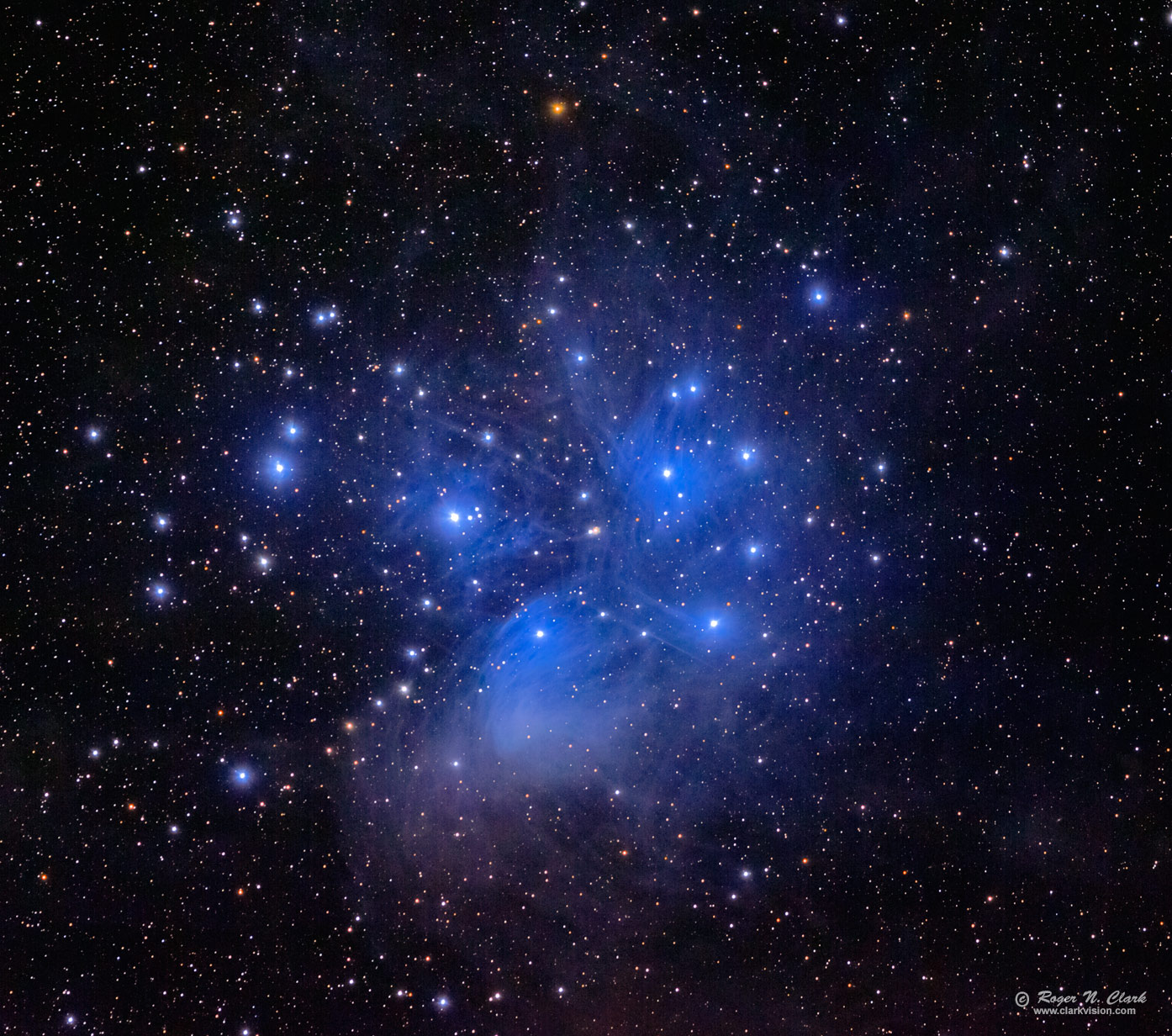| Home | Galleries | Articles | Reviews | Best Gear | New | About | Contact | Gallery Index | Previous |
Next |

| Home | Galleries | Articles | Reviews | Best Gear | New | About | Contact | Gallery Index | Previous |
Next |

The Pleiades star cluster, also known as the Seven Sisters is immersed in nebulosity due to scattered starlight.
Technical. Canon 7D Mark II 20 megapixel digital camera and 300 mm f/2.8 L IS II lens at f/2.8. 26 one-minute exposures at ISO 1600 were added (26 minutes total exposure). No dark frame subtraction, no flat fields, no noise reduction. Tracking with an astrotrac. This image is 45% of full resolution.
Post processing: stretched with rnc-color-stretch. Also see Astrophotography Image Processing Basic Work Flow.
Modern DSLRs like the 7D Mark II include on sensor dark current suppression and low fixed pattern noise at ISOs around 1600 and higher, making no need for dark frame subtraction. Modern raw converters correct for light fall-off and also correct for hot/dead/stuck pixels. This makes processing low light images easy: simply align and average. Compare this image to the M45 made with a 7D Mark 1 with almost the same exposure time and almost the same sky conditions.
This is a natural color image. The high dynamic range of astrophotos must be stretched to bring out the range of details the camera recorded. But the typical image stretch process loses color for brighter subjects (e.g. stars and the brighter parts of deep sky objects become whiter as they are made brighter). This image uses a new algorithm, rnc-color-stretch that does not lose color during the stretch. How do we know the colors are reasonable? The star colors can be checked against stellar photometry. The color of the nebulosity is quite blue. The measured B-V color index for the nebula around the star Merope (lower left bright star in the image) is about -0.5 to -0.6. The B-V index of the sun is +0.63, so for daylight white balance (sun = white) the B-V would be a little less than 1 magnitude (-0.6 - 0.63), or a linear ratio of a little over 2.5 (or B < 1/2.5 or 0.4 that of V). V is close to the green passband in a digital camera, and B is a little bluer, so we expect the digital camera ratio to be a little less extreme. Indeed, the blue intensity values in the image are only about half that of green, consistent with the B-V difference. The color should appear similar to a very deep blue clear daytime sky. The more common images you see with lighter blues or cyan color are artifacts of stretching.
The Exposure Factors, CEF, CEFA are measures of the relative amounts of light received from a subject. It can be used to fairly compare wildly different lens/telescope apertures and exposure times. For this image:
The surface brightness of the Pleiades nebulosity is very low (see surface brightness of the nebulae in M45 ).
To learn how to obtain stunning images like this, please visit my Extensive Articles on Photography .
See my review of the Canon 7D Mark II and why it is so good for astrophotography: Canon 7D Mark II sensor analysis.
Keywords to this image = astrophoto-1 star_cluster Messier night low-light digital_astro canon_7d2 rnc-color-stretch NEW
Image ID: pleiades.m45.rnclark.c11.21.2014-acr-t20J6A1575-1629-t3b-rs.e-1394vs.jpg
| Home | Galleries | Articles | Reviews | Best Gear | Science | New | About | Contact |
Last updated August 26, 2017